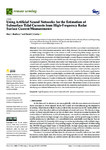Using Artificial Neural Networks for the Estimation of Subsurface Tidal Currents from High-Frequency Radar Surface Current Measurements
| dc.contributor.author | Bradbury, MC | |
| dc.contributor.author | Conley, Daniel | |
| dc.date.accessioned | 2021-10-14T10:53:32Z | |
| dc.date.available | 2021-10-14T10:53:32Z | |
| dc.date.issued | 2021-09-29 | |
| dc.identifier.issn | 2072-4292 | |
| dc.identifier.issn | 2072-4292 | |
| dc.identifier.other | ARTN 3896 | |
| dc.identifier.uri | http://hdl.handle.net/10026.1/18053 | |
| dc.description.abstract |
<jats:p>An extensive record of current velocities at all levels in the water column is an indispensable requirement for a tidal resource assessment and is fully necessary for accurate determination of available energy throughout the water column as well as estimating likely energy capture for any particular device. Traditional tidal prediction using the least squares method requires a large number of harmonic parameters calculated from lengthy acoustic Doppler current profiler (ADCP) measurements, while long-term in situ ADCPs have the advantage of measuring the real current but are logistically expensive. This study aims to show how these issues can be overcome with the use of a neural network to predict current velocities throughout the water column, using surface currents measured by a high-frequency radar. Various structured neural networks were trained with the aim of finding the network which could best simulate unseen subsurface current velocities, compared to ADCP data. This study shows that a recurrent neural network, trained by the Bayesian regularisation algorithm, produces current velocities highly correlated with measured values: r2 (0.98), mean absolute error (0.05 ms−1), and the Nash–Sutcliffe efficiency (0.98). The method demonstrates its high prediction ability using only 2 weeks of training data to predict subsurface currents up to 6 months in the future, whilst a constant surface current input is available. The resulting current predictions can be used to calculate flow power, with only a 0.4% mean error. The method is shown to be as accurate as harmonic analysis whilst requiring comparatively few input data and outperforms harmonics by identifying non-celestial influences; however, the model remains site specific.</jats:p> | |
| dc.format.extent | 3896-3896 | |
| dc.language | en | |
| dc.language.iso | en | |
| dc.publisher | MDPI | |
| dc.subject | high-frequency radar | |
| dc.subject | neural networks | |
| dc.subject | tidal resource assessment | |
| dc.subject | ocean currents | |
| dc.title | Using Artificial Neural Networks for the Estimation of Subsurface Tidal Currents from High-Frequency Radar Surface Current Measurements | |
| dc.type | journal-article | |
| dc.type | Journal Article | |
| plymouth.author-url | https://www.webofscience.com/api/gateway?GWVersion=2&SrcApp=PARTNER_APP&SrcAuth=LinksAMR&KeyUT=WOS:000726643600001&DestLinkType=FullRecord&DestApp=ALL_WOS&UsrCustomerID=11bb513d99f797142bcfeffcc58ea008 | |
| plymouth.issue | 19 | |
| plymouth.volume | 13 | |
| plymouth.publication-status | Published online | |
| plymouth.journal | Remote Sensing | |
| dc.identifier.doi | 10.3390/rs13193896 | |
| plymouth.organisational-group | /Plymouth | |
| plymouth.organisational-group | /Plymouth/Faculty of Science and Engineering | |
| plymouth.organisational-group | /Plymouth/PRIMaRE Publications | |
| plymouth.organisational-group | /Plymouth/REF 2021 Researchers by UoA | |
| plymouth.organisational-group | /Plymouth/REF 2021 Researchers by UoA/UoA07 Earth Systems and Environmental Sciences | |
| plymouth.organisational-group | /Plymouth/Research Groups | |
| plymouth.organisational-group | /Plymouth/Research Groups/Marine Institute | |
| plymouth.organisational-group | /Plymouth/Users by role | |
| plymouth.organisational-group | /Plymouth/Users by role/Academics | |
| dcterms.dateAccepted | 2021-09-22 | |
| dc.rights.embargodate | 2021-10-15 | |
| dc.identifier.eissn | 2072-4292 | |
| dc.rights.embargoperiod | Not known | |
| rioxxterms.versionofrecord | 10.3390/rs13193896 | |
| rioxxterms.licenseref.uri | http://www.rioxx.net/licenses/all-rights-reserved | |
| rioxxterms.licenseref.startdate | 2021-09-29 | |
| rioxxterms.type | Journal Article/Review | |
| plymouth.funder | Flow & Benthic Ecology 4D (FLOWBEC)::NERC |


